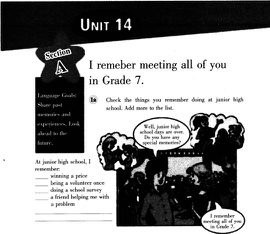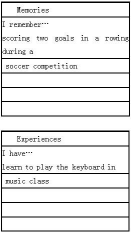根据提供的信息和语言素材设计教学方案。用英文作答。
设计任务:请阅读下面学生信息和语言素材,设计一节听力课的教学方案。教案没有固定格式.但须包含下列要点:?
teaching objectives?
teaching contents?
key and difficult points?
major steps and time allocation?
activities and justifications
教学时间:45分钟?
学生概况:某城镇普通中学七年级(初中一年级)学生,班级人数40人,多数学生已经达到《义务教育英语课程标准(20i l年版)》二级水平,学生课堂参与积极性一般。
语言素材:?
Listen and match the memory with the person.
__ Mary a. used to be scared of a teacher with high standards.
__ Frank b. remember losing a schoolbag.
__ Sarah c. remembers meeting this group of friends.
__ Peter d. has enjoyed every year of junior high school.


正确答案及解析
正确答案
解析
Teaching Content: A listening material about "I remember meeting all of you in Grade 7".
Teaching Objectives:
(1) Knowledge objectives
①Students can consolidate the usage of remember and the sentence pattern "I remember doing sth".
② Students can be more familiar with the topic of memories.
(2) Ability objectives
According to study, students can improve their skills of listening for specific information and can talk about the meaningful and unforgettable memories in English freely.
(3) Emotional objectives
① Students can find out some meaningful memories from the past experience to encourage themselves studying hard.
②Students can understand we should cherish present and do our best to create a bright future.
③ Students can improve the confidence of learning English, and are not afraid of speaking English.
Teaching Key Points:
How to make students improve their skills of listening for specific information.
Teaching Difficult Point:
How to make students use the knowledge they learnt before to talk about the things happened in the past.
Teaching Aids: a tape recorder, multimedia, pictures
Teaching Methods: Communicative Approach, Task-based Teaching Method, Audio-Lingual Approach.
Teaching Procedures:
Step 1 Lead-in (5 minutes)
The teacher shows some photos about students' junior high school and play the music named"Seasons in the Sun" to let students look back on their junior high school memories, and told them today they are going to learn to express their memories in English.
T: (after listening) Now, who can tell me what's the subject of this song
S: About youth.
T: Yes, it's about youth. Very good. This is the last unit of our English book. In this unit, we will mainly talk about our past school lives.
(Justification: This step could attract students' attention and lead in the new lesson easily.)
Step 2 Pre-listening (10 minutes)
Teacher asks students to look at the picture in this unit, and asks students to finish the task in la. Then asks students to check the things they remember doing at junior high school and add more things they remember as much as possible.
T: Now, look at the picture. What kind of party do you think it is Is it a welcome party or graduation party
S: Graduation party.
T: Look at the small pictures. What are the boy and girl talking about Try to guess!
S: (Discussing)
T: OK. Let's look at the small scenes in this big picture. What does the girl remember doing According to the pictures, please have a guess and finish the task in la. Do you understand
S: Yes!
T: And you are supposed to write down some more items about what you remember doing in your past school time. Ok, now, let's do it.
(Justification: This step can attract students' attention and help and encourage them to foucus on the content of what they are about to hear.)
Step 3 While-listening (13 minutes)
(1) Teacher asks students to listen to the tape and match the memory with the person. Then asks them to tell their answers to their partners.
T: Ok, now, let's move on to our listening. Listen to the tape and match the memory with the person. And tell your answer to your partner by using sentences, such as, Peter remembers doing homework carefully to meet the standards of a strict teacher. Are you clear
S: Yes!
T: Now, let's begin!
Students listen to the tape.
T: Ok, now, who can tell us your answers
SI: Sarah remembers losing a schoolbag ...
T: Ok, very good. Sit down, please.
$2: ...
(2) Then the teacher plays the tape again, and asks students to read after the record.
T: Now, I will play the record again and you are supposed to read after the record silently. Any questions
S: No.:
T: Ok, now, please listen to the tape. While listening, please pay more attention to the pronunciation and
intonations.
(Justification:This step make students listen and enjoy what they are listening. The task of matching the memorizing and with the person makes students focus on the listening itself. )
Step 4 Post-listening (12 minutes)
(1) The teacher asks students to make a dialogue with their deskmates by using the list in la.
T: Now, you are supposed to make a dialogue with your deskmate according to the list you wrote in la. Here is a conversation structure, you can make your dialogue according to it.
(Then the teacher writes the example on the blackboard.)
Example:
--What do you remember doing
--I remember doing my homework very late till to 12 o'clock. What do you remember doing
--Well, I remember winning a prize. And my parents took me to the biggest amusement park in our city.
--Wow!It's cool. What else do you remember
--I still remember playing basketball on the playground with you and singing songs with our best friends.
--Yes, wonderful and colorful.
The teacher chooses one student and his/her deskmate to present their dialogue in front of the class and gives
some feedback.
(2) T: Now, look at the chart on PPT, I need you to make an interview. Interview some classmates and record at least three memories of thetn. Then fill the chart and make dialogue with your deskmates. Any questions
S: No.
T: Good. Let's do it. After finished, I will invite three groups to share their dialogues, and the best group will get a reward.
(Justification: This step is easier for students' to have a high motivation to speak. According to their make dialogue with their deskmates can test the students' listening comprehension.)
Step 5 Summary and Homework (5 minutes)
Summary: Ask students to think about the key sentence structures they listened today, and then make a short summary.
Homework: Ask students to look back on their school life, and communicate these colorful feelings with their friends.
Blackboard Design:
Unit 14 I remember meeting all of you in Grade
Pre-listening:
While-listening:
Post-listening:
Example:
--What do you remember doing
--I remember doing my homework very late till to 12 o'clock. What do you remember doing
--Well, I remember winning a prize. And my parents took me to the biggest amusement park in our city.
--Wow!It's cool. What else do you remember
--I still remember playing basketball on the playground with you and singing songs with our best friends.
--Yes, wonderful and colorful.
Teaching reflection.
包含此试题的试卷
你可能感兴趣的试题
教师职业道德区别于其他职业道德的显著标志就是( )。
-
- A.为人师表
- B.清正廉洁
- C.敬业爱业
- D.团结协作
- 查看答案
在教育史上主张“不愤不启,不悱不发”的教育家是()。
-
- A.孔子
- B.孟子
- C.荀子
- D.韩非子
- 查看答案
心理学家所说的“危险期”或“心理断乳期”是指( )。
-
- A.童年期
- B.少年期
- C.青年期
- D.成年期
- 查看答案
教育工作中做到“因材施教”、“长善救失”符合年轻一代身心发展的( )。
-
- A.顺序性
- B.个别差异性
- C.不平衡性
- D.互补性
- 查看答案
德育过程与品德形成过程的关系是( )。
-
- A.是一致的,可以等同
- B.教育与发展的关系
- C.相互促进的关系
- D.相互包容的关系
- 查看答案